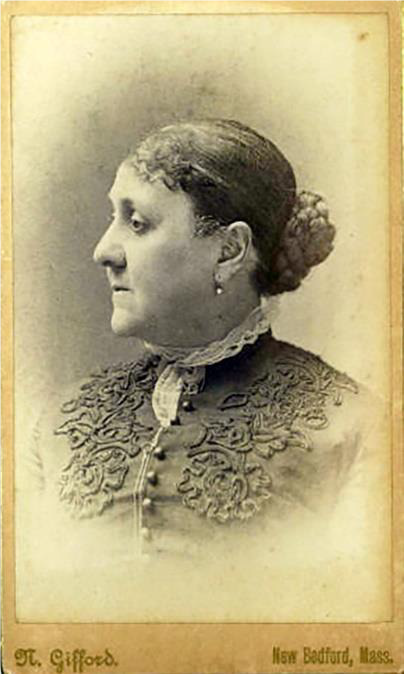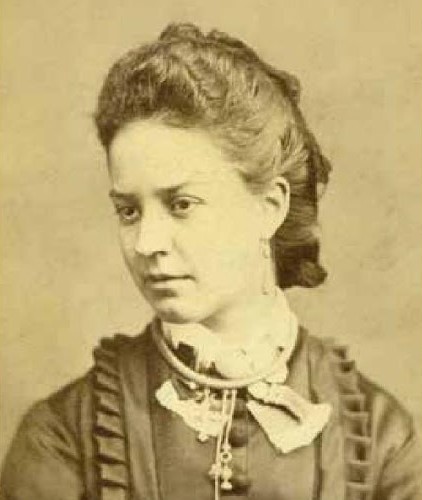Acushnet’s Laura Keene (1826-1873) is best known as an actress who starred in Our American Cousin at Ford’s Theater the night President Lincoln was assassinated. Much more than an actress, she was an entrepreneur, playwright, director and theater manager. Laura Keene Avenue, named in her honor, is located near her beloved property, Riverside Lawn in Acushnet.
Laura Keene (1826-1873) was reportedly born Mary Frances Moss on July 20, 1826 in Winchester, England. After performing on the London stage, she came to America in 1852. She was best known for performing in Our American Cousin on the night Lincoln was assassinated at Ford’s Theater in Washington, D.C., but there was more to her life than just that one incident.
Her early life was rather tumultuous. At 17 she married Henry Wellington Taylor, purportedly a nephew of the Duke of Wellington. A year later she had a daughter Emma and four years after, another daughter Clara. During that time, she and her husband evidently ran a pub. When Henry was arrested, convicted of a crime and shipped to a penal colony in Australia, Laura became a “single mother.”
Her aunt Elizabeth, a former actress, decided that Mary Frances should apprentice with a theater company. At this point Mary Frances had to re-invent herself as it was unacceptable for a woman with children and no husband to be working in the theater. Acting was considered only one step above circus performers on the low end of the social scale. And so … she became Laura Keene. Her now widowed mother Jane took charge of her daughters, who started to call their mother “Auntie.” Laura was convinced to move to New York where there were more opportunities.
Laura did well in the theater, was paid well and was able to send for her mother and the two girls to join her. She started her own theater company in Baltimore. Just two years later it was well received, and she was encouraged to take her company to California during the Gold Rush days. Life did not go as well there, and she consequently decided to head to Australia in search of her missing husband. While in Australia she met up with Edwin Booth, an actor from the famous Booth family. Both were able to get work touring Australia, although she was unsuccessful in finding the missing Henry.
On her return to the United States Laura met a wealthy man named John Lutz who was to play a major role in running the financial aspect of the business and later her own theater. (They did eventually marry when both of their prior spouses had died.) At that time, her daughters were either with Jane or boarding in a convent. As the girls got older they also became involved in the theater business, either in management or supporting and/or singing roles.
During the Civil War Laura and her theater company kept busy performing in both the North and the South. The March 5, 1865 edition of the New Bedford Evening Standard includes an ad for “Miss Laura Keene in Our American Cousin” at New Bedford’s Liberty Hall. Laura had also written a series of plays called “The Workman of . . .” which could become “The Workman of Boston, New York, New Orleans” as needed. During this busy time, she had one small break. While performing in Boston she and John Lutz made a visit to Acushnet to a place called Kempton Farm. After enjoying a picnic in this calm and peaceful place, John told her that he had bought the farm as a part of her property portfolio. She was delighted with the purchase, planned to return to the area in the future and began referring to her new acquisition as Riverside Lawn.
At the end of the war she was between performances and was given the chance to play a role in a special celebratory performance of Our American Cousin for President Lincoln. When John Wilkes Booth shot the president during the performance, he then vaulted over the box and ran to the stage door where Laura was standing. After having known him from years acting together, she quickly moved out of his way when she saw his crazed look. She then went on stage to calm the panicked audience and managed to initiate an orderly exit from the theater. Rumors began to spread that Lincoln had been shot by an actor and they all must have been in on the shooting. She was again able to quell the rumor and restore order. Laura then made her way up to the presidential box. She initially tried to comfort Mrs. Lincoln but the woman was overcome by shock. Laura then realized that no one was giving Lincoln himself any comfort and asked if she might do so. One of the doctors said she could. Laura knelt, lifting the wounded Lincoln onto her lap; she wiped his face with a moistened cloth and held him until he was transferred to a private home across the street.
Afterward she and John Lutz packed up their belongings, boarded a train to their next engagement, although still shattered by the events at Ford’s Theater. She was subsequently arrested and questioned about her involvement in the assassination. Lutz was able to get her released with help from family connections, after she gave her report on what had occurred. They continued to Cincinnati for her upcoming performances. It was there that she encountered the clamor for “pieces of the dress containing Lincoln’s blood.” She was stunned and appalled to think that people would think she would ever wear the dress again. The gown was wrapped in silk, boxed, sent to its designer Jamie Bullock in Chicago and consequently out of their lives. They eventually returned to Riverside Lawn in Acushnet and she began to renew her energies and her spirit.
Acushnet was a special healing place for Laura. Fresh air, good food, walks by the river and the peace and quiet. She renewed her love of art and spent days dabbling in oil painting. She poured her heart into the property by keeping 40 acres in active cultivation. She planted fruit and ornamental trees and a kitchen garden. For guests Laura put in a curved driveway from the country road and added bathing houses on the bank of the river. For the next three years, she would do short theatrical tours and then return to the sanctuary of Riverside Lawn. The family loved their time in Acushnet. Daughter Clara sang at St. Lawrence Church in New Bedford and Laura’s mother Jane attended Grace Episcopal Church there.
It was at Riverside Lawn that her latest venture was begun – a theatrical magazine titled The Fine Arts. Laura and her daughters spent considerable time on article policy, suitable material and the research and writing of appropriate articles. Its first appearance in February of 1872 was received with great enthusiasm by the New York press. The magazine did not, however, have a long life. It was well done, beautiful, using the best materials but the expense of producing it resulted in a short life span.
In 1873 Laura signed Riverside Lawn over to Clara so that her younger daughter would have something to depend on. Emma had married a Mr. Rawson who would provide for her. Laura wrote to designer Jamie Bullock asking for the return of the stained gown, bequeathing the dress to Clara. Laura finalized all her business dealings, her plays, writings and more. At age 47, Laura Keene passed away in New York in November 1873 from consumption.
Her original Acushnet home suffered a fire a few years after her death but was subsequently rebuilt. Laura Keene Avenue, named in her honor, is located near her beloved Riverside Lawn. While she did not spend a great deal of her life in the region, Acushnet and Riverside Lawn played very important roles in her life and she cherished her time here. Her legacy–of plays, writings, theatrical performances, innovations in theater management–was no small achievement, done by a woman in a time when most women were regarded as ornamental.
Maureen McCarthy
Information from
- Bryan, Vernanne. Laura Keene: A British Actress on the American Stage, 1826-1873. McFarland, 1997.
- Hall, Robert. “From the Village: Acushnet’s Laura Keene Was Performing at Ford Theater on Fateful Evening When President Lincoln Was Shot.” SouthCoast Today, 14 Apr. 2011, http://www.southcoasttoday.com/article/20110414/PUB01/104140362.
- Henneke, Ben G. Laura Keene: Actress, Innovator and Impresario. Council Oak Books, 1990.
![[Laura Keene], between 1855 and 1865, Photograph, Library of Congress Photo of actress Laura Keene](https://historicwomensouthcoast.org/wp-content/uploads/2020/02/Laura-Keene-600x600-1.jpg)




